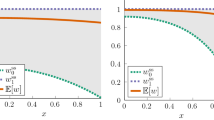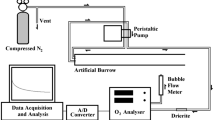Abstract
An analytical model is developed that describes oxygen transport and oxygen consumption for small biological structures without a circulatory system. Oxygen inside the organism is transported by diffusion alone. Oxygen transfer towards the organism is retarded by a thin static fluid film at the surface of the organism. The thickness of this film models the outward water conditions, which may range from completely stagnant water conditions to so-called well-stirred water conditions. Oxygen consumption is concentration-independent above a specified threshold concentration (regulator behaviour) and is proportional to the oxygen concentration below this threshold (conformer behaviour). The model takes into account shape and size of the organism and predicts the transition from (pure) regulator behaviour to (pure) conformer behaviour, as well as the mean oxygen consumption rate. Thereby the model facilitates a proper analysis of the physical constraints set on shape and size of organisms without an active internal oxygen transport mechanism. This analysis is carried out in some detail for six characteristic shapes (infinite sheet, cylinder and beam; finite cylinder, sphere and block). In a well-stirred external medium, a flattened shape appears to be the most favourable for oxygen supply, while a compact shape (cube) is more favourable if the external medium is nearly stagnant. The theoretical framework is applied to oxygen consumption data of eight teleost embryos. This reveals relative insensitivity to external flow conditions in some species (e.g., winter flounder, herring), while others appear to rely on external stirring for a proper oxygen supply (e.g., largemouth bass). Interestingly, largemouth bass is the only species in our analysis that exhibits ‘fin-fanning’.
Similar content being viewed by others
References
Abramowitz, M. and I. A. Stegun (Eds) (1965). Handbook of Mathematical Functions, New York: Dover.
Byatt-Smith, J. G., H. J. Leese and R. G. Gosden (1991). An investigation by mathematical modelling of whether mouse and human preimplantation embryos in static culture can satisfy their demands for oxygen by diffusion. Hum. Reprod. 6, 52–57.
Carslaw, H. S. and J. C. Jaeger (1959). Conduction of Heat in Solids, 2nd edn, New York: Oxford University Press.
Churchill, R. V. (1955). Extensions of operational mathematics, Proc. Conf. Diff. Eqns., University of Maryland.
Clift, R., J. R. Grace and M. E. Weber (1978). Bubbles, Drops, and Particles, New York: Academic Press.
Daykin, P. N. (1965). Application of mass transfer theory to the problem of respiration of fish eggs. J. Fish. Res. Bd Can. 22, 159–171.
Desaulniers, N., T. S. Moerland and B. D. Sidell (1996). High lipid content enhances the rate of oxygen diffusion through fish skeletal muscle. Am. J. Physiol. 271, R42–R47.
Dowse, H. B., S. Norton and B. D. Sidell (2000). The estimation of the diffusion constant and solubility of O2 in tissue using kinetics. J. Theor. Biol. 207, 531–541.
Fairweather, G. (1978). Finite Element Galerkin Methods for Differential Equations, New York: Dekker.
Fenn, W. O. (1927). The oxygen consumption of frog nerve during stimulation. J. Gen. Physiol. 10, 767–779.
Gerard, R. W. (1931). Oxygen diffusion into cells. Biol. Bull. 60, 245–268.
Gielen, J. L. W. (2000). The general packed column: an analytical solution. IMA J. Appl. Math. 65, 123–146.
Graham, J. B. (1988). Ecological and evolutionary aspects of integumentary respiration: body size, diffusion and the Invertebrata. Am. Zool. 28, 1031–1045.
Harvey, E. N. (1928). The oxygen consumption of luminous bacteria. J. Gen. Physiol. 11, 469–475.
Kranenbarg, S., M. Muller, J. L. W. Gielen and J. H. G. Verhagen (2000). Physical constraints on body size in teleost embryos. J. Theor. Biol. 204, 113–133.
Kranenbarg, S., J. H. G. Verhagen, M. Muller and J. L. Van Leeuwen (2001). Consequences of forced convection for the constraints on size and shape in embryos. J. Theor. Biol. 212, 521–533.
Krogh, A. (1919). The rate of diffusion of gases through animal tissues, with some remarks on the coefficient of invasion. J. Physiol. Lond. 52, 391–408.
Krogh, A. (1941). The Comparative Physiology of Respiratory Mechanisms. Philadelphia, PA: University of Pennsylvania Press.
Lee, C. E. and R. R. Strathmann (1998). Scaling of gelatinous clutches: effects of siblings competition for oxygen on clutch size and parental investment per offspring. Am. Nat. 151, 293–310.
Longmuir, I. S. (1957). Respiration rate of rat-liver cells at low oxygen concentrations. Biochem. J. 65, 378–382.
Padilla, P. A. and M. B. Roth (2001). Oxygen deprivation causes suspended animation in the zebrafish embryo. PNAS 98, 7331–7335.
Rosen, J. B. (1952). Kinetics of a fixed bed system for solid diffusion into spherical particles. J. Chem. Phys. 20, 387–394.
Scott, W. B. and E. J. Crossman (1973). Freshwater Fishes of Canada. Ottawa: Fisheries Research Board of Canada, Bulletin 184.
Seymour, R. S. and D. F. Bradford (1987). Gas exchange through the jelly capsule of the terrestrial eggs of the frog, Pseudophryne bitroni. J. Comp. Physiol. B 157, 477–481.
Strathmann, P. R. and C. Chaffee (1984). Constraints on egg masses. II. Effects of spacing, size, and number of eggs on ventilation of masses of embryos in jelly, adherent groups, or thin-walled capsules. J. Exp. Mar. Biol. Ecol. 84, 85–93.
Warburg, O. (1923). Versuche an überlebendem carcinoomgewebe. Methoden]. Biochem. Z. 142, 317–333.
Wickett, W. P. (1975). Mass transfer theory and the culture of fish eggs, in Chemistry and Physics of Aqueous Solutions, W. A. Adams, G. Greer, J. E. Desnoyers, G. Atkinson, G. S. Kell, K. B. Oldham and J. Walkley (Eds), Princeton: The Electrochemical Society, Inc., pp. 419–434.
Author information
Authors and Affiliations
Rights and permissions
About this article
Cite this article
Gielen, J.L.W., Kranenbarg, S. Oxygen balance for small organisms: An analytical model. Bull. Math. Biol. 64, 175–207 (2002). https://doi.org/10.1006/bulm.2001.0275
Received:
Accepted:
Issue Date:
DOI: https://doi.org/10.1006/bulm.2001.0275




